1974 Dutch Grand Prix race report
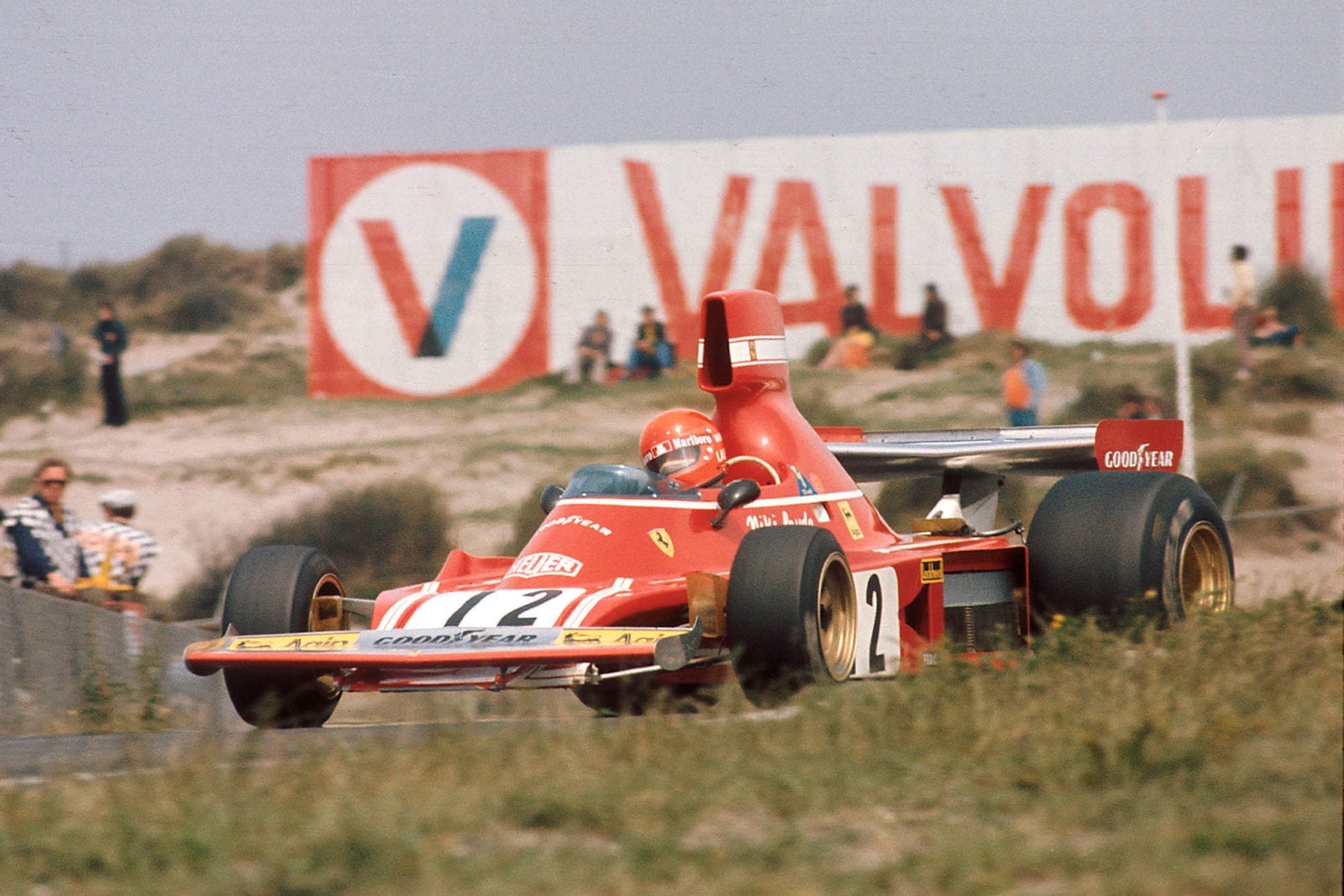
Ferrari's Niki Lauda scored his third win of 1974 at Zandvoort
Motorsport Images
Ferrari all the way
Zandvoort, June 23rd: The Grand Prix scene moved from the flat Anderstorp circuit in Sweden to the undulating Zandvoort circuit in Holland in a period of two weeks, and between times quite a lot happened. Team Lotus called in at Zandvoort on their way back from Sweden and had Peterson test the Lotus 76-JPS/9 and promptly had an accident when some experimental brake pads gave trouble. The Lotus was quite badly damaged and the Swede was knocked a bit unconscious, but otherwise escaped injury, and was all fit and ready to go again when everyone gathered for the Dutch Grand Prix. During the intervening period there had been a bit of a shin-dig at high levels involving the CSI, the Formula One Constructors Association and the Dutch organisers, over who should be invited to qualify and who should not. On the practical side of things, such as paddock and pit space, circuit length, practice time available and so on, there are beginning to be too many aspiring Formula One contestants for the situation, but this indicates that the racing scene is outgrowing the circuit scene, so that the circuits should be enlarged, not the entries reduced, and certainly not reduced by “closed shop” union methods such as the Formula One Constructors are trying to do. The CSI, pressured strongly by the RAC, came out on the side of freedom and liberty and said that anyone and everyone should be given the chance to qualify for the starting grid of a Grand Prix, the number of starters being dependent on the length of the circuit, as always, and that any organiser who refused to do this would not be granted World Championship status next year. If the pits or paddock are not big enough for the current scene then they should be enlarged. This little argy-bargy cleared the air a bit and put certain “entrepreneurs”, who think they ought to be running the scene, in their right and proper place.
The number of cars permitted to run on the Zandvoort circuit is 25, and a total of 28 drivers were milling around the pits ready to start practice, with some 38 cars between them, but when practice got under way at mid-day on Friday June 21st there were only 27 drivers active. John Surtees and Carlos Pace were in the throes of a personality conflict, not surprising after Pace’s childish showing in Sweden, with the result that the Brazilian was standing about idly while his car, Surtees TS16/03, never left the paddock. In the BRM pit Pescarolo had gone all temperamental because Beltoise wanted to try both of the new P201 cars, which left the three-times Le Mans winner with an old P160 BRM, so he wandered off in a gloom. Everyone else was either happy, like the Ferrari team, confident like the Tyrrell team, optimistic like the Hesketh team or hopeful like the Graham Hill Lola team. There were no revolutionary breakthroughs on the mechanical scene, but lots of detail work had been done before the event, and there were some personnel changes. Lotus were relying on their two usual 72 models for Peterson and Ickx, the cars scintillating like never before in new coats of black and gold John Player paint, while Lotus 76-JPS/10 was ready for Ickx to experiment with, having its water radiators mounted much further forward, just behind the front wheels, with new side ducting. The Tyrrell pair, Scheckter and Depailler, had their usual cars, with the Donington Collection’s Tyrrell 006/2 in the paddock for emergency use, and among the detail experiments they were trying were some extended shrouds over the side-mounted water radiators on Depailler’s car. Fittipaldi and Hulme had the Texaco-Marlboro supported works McLarens with their usual variety of instant adjustments to wheelbase, rear end geometry and aerofoil position, while Fittipaldi’s car, M23/5 had new inlet trumpets to its Cosworth engine, bringing them closer together towards the centre of the car to allow a new slimmer and smoother air-collector box. The spare car was marked down to Fittipaldi, while the “show-car” was lying in the sand in the entrance road to the circuit, with Dutch enthusiasts climbing all over it. The Brabham team had their usual trio of BT44 cars for Reutemann and von Opel, with Pace sniffing round to see if he could fit into a Brabham. In conjunction with Goodyear Reutemann was trying some new tyres on 10 inch diameter rims, that really did look like cotton-reels. Stuck and Brambilla were in the works March cars and Regazzoni and Lauda had Ferrari 014 and 015, respectively, with 011 standing by as a spare, with Regazzoni’s number on it, but it was never used. The rear aerofoils on the Ferraris had a new trailing edge shape, which was of vee formation, but the engineers did not seem to be letting on as to why. BRM were still trying to run three cars, with their two P201 models, and P160/10, for Beltoise, Pescarolo and Migault, and the Shadow team had three cars but were content to run only two drivers, Jarier being joined by the Welshman Torn Pryce taking Redman’s place. Team Surtees had made a big effort to get rid of the Shambles Trophy, and had a brand new car ready to go. A sizeable amount of weight had been transferred to the rear, by moving the battery to a mounting behind the gearbox, and making new water radiators that lay across the rear of the car, just under the rear aerofoil. This allowed a much smoother and longer nose cowling, devoid of openings, and the flat extensions on the cockpit sides had been done away with. In addition the front suspension geometry had been revised and all in all it was hoped that this new car, TS16/05 for Jochen Mass, would not suffer the same dreaded understeer of which the drivers were complaining. An indication of the situation in the team was that John Surtees had entered himself as driver in the spare car, TS16/04, but he never showed signs of taking up the option. Frank Williams was happy to have the effervescent Merzario back in the cockpit, even though his damaged hand was still not fully mended, and in the second Williams car, Gijs van Lennep was having a go at qualifying for his own Grand Prix, all part of the Williams “fluid-team, sponsored by Marlboro”. Teddy Yip was happily putting some Eastern hieroglyphics on Maurice Nunn’s Ensign MN02, which spelt out Theodore Racing, for those who understood Chinese or Japanese, or just plain fretwork, and Schuppan was driving as usual, and next to them Ron Tauranac had the Trojan for Tim Schenken, with a new full-width front aerofoil above the nose, like a Ferrari, among other mods in the search of raceworthiness of a new design. M’Lord Hesketh was back to strength with his two Hesketh cars for Hunt, but the prototype 308/1 was strictly an emergency spare and not a time-wasting alternative to 308/2. Hill and Edwards had their usual three immaculate Lolas, sponsored by Embassy, and the lonesome Hailwood with his Yardley McLaren was alongside the other works McLarens in spirit if not colour.
Qualifying
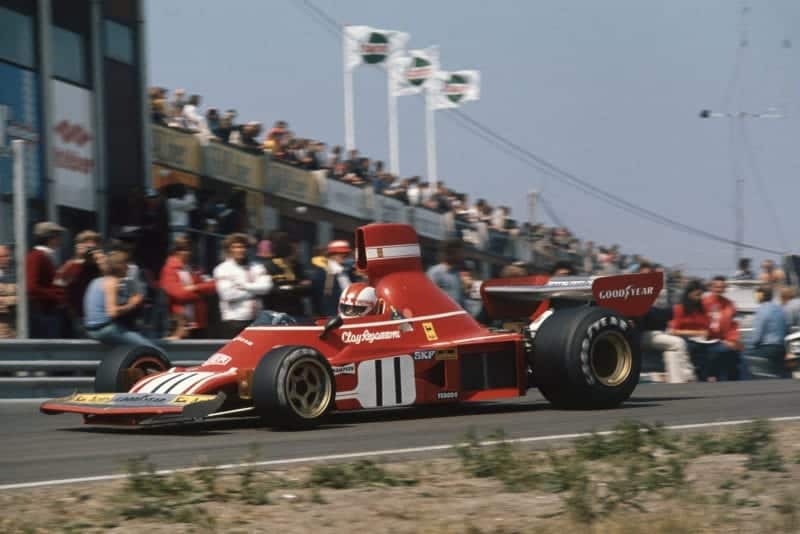
Clay Regazzoni was 2nd to Ferrari team-mate Lauda in qualifying
Motorsport Images
There was more than sufficient time for practice, and most people put in a phenomenal number of laps in getting ready for the 75-lap race. Most of Friday and Saturday was given over to practice, with a break halfway through to collect up any derelict cars, and for a general gathering of the breath. A strong wind along the main straight made the drivers keep their heads down, and aerofoil “experts” were fiddling with their fins and wings and things, trying to cut down drag along the straight without losing out on down-force round the corners. However, the main thing that everyone was doing was to try and see which way the two Ferraris had gone, for Regazzoni and Lauda powered off into the distance from the word go, leaving all the Cosworth runners breathless, while the BRM team hardly seemed to be breathing at all. Poor old Surtees was still in trouble for just when Mass was getting all enthusiastic about the new car the Cosworth engine sprung an oil leak and the stocky German had to revert to the practice car, and as the team juggled with the stick on numbers, the time-keepers and few others had much idea of what Surtees car was doing what. BRM were also confusing the time-keepers by changing numbers about on their three cars, using 14, 14T, 15, 37 and 37T between their three drivers, not that it had any effect on the overall scene. As expected it was “never-say-die” Peterson who was hard on the heels of the two Ferraris in the first half of practice, with 1 min. 20.22 sec., but it was a fair distance from the red cars, which had done 1 min. 19.51 sec. and 1 min. 19.71 sec., respectively, for Regazzoni and Lauda. During the breathing space it was clear that a lap in under 1 min. 20 sec. was the aim for any Cosworth-powered driver, if he was to keep the Ferraris in sight, and after the break Scheckter did just that, with 1 min. 19.91 sec., but Lauda had rewritten the standards with a lap in 1 min. 18.91 sec., so everyone had to have another think. While Peterson was trying hard to keep the Lotus flag flying Ickx was doing some test driving with the Lotus 76 and it was beginning to show promise, though the Belgian was not over-enthusiastic about it.
On Saturday the wind was still blowing, but it was still fine and dry, if somewhat grey, and practice started at mid-morning, with everyone pretty fired up with some objective in mind, either to keep the Ferraris in sight, to justify their positions, not get left behind, or not to be odd men out at the back, it was clear now that Pace would not be driving his Surtees, but Pescarolo had joined in, somewhat disgruntled, so the slowest two drivers were going to be nonstarters. The Cosworth brigade were getting to grips with the under 1.20 target, Fittipaldi, Hunt and Hailwood joining Scheckter in the elite group, but Lauda rewrote the standard once more with a lap in 1 min. 18.31 sec., a huge improvement on the fastest practice lap of 1973 which was Peterson’s 1 min. 19.47 sec. The Swede having made his bid for the front row on the previous day, spent the Saturday practice running in race-trim, with full tanks and race tyres, rather than short-life practice tyres. In full view of his pit Ickx had the Cosworth engine in his Lotus 72 blow up and coasted to a stop in a cloud of oil smoke and nasty noises, having to continue practice back in the Lotus 76. Team Surtees had repaired the new car for Jochen Mass and he was getting along fine with it when he went off the road at the new ess-bend on the back of the circuit and did more damage to the monocoque than could be repaired in the paddock, so he went back to his older car. The speed of the two Ferraris had got all the top runners in a bit of a twitch, not to say something of a panic, and Scheckter tried out a different top gear ratio only to go slower and have to have it changed back to what had been calculated to be correct. With Lauda and Regazzoni firmly established on the front row of the grid the Scuderia Ferrari were able to free-wheel through the last part of practice and when it was all over they were the only two in the 1 min. 18 sec. bracket, with Fittipaldi, Hailwood, Scheckter and Hunt in the 1 min. 19 sec. bracket. Then came a whole bunch in the 1 min. 20 sec. bracket, comprising Jarier, Depailler, Hulme, Peterson, Pryce, Reutemann and Watson. Of these Pryce was particularly praiseworthy, it being his first time out in a UOP-Shadow, and Watson equally so as his Brabham is privately run by the Hexagon-of-Highgate team and is a 1973 model.
At the back of the field it was Schenken and van Lennep who got left behind, a mere three-hundredths of a second separating them, and a mere three-tenths from Migault putting them out of the race. Ron Tauranac took his Trojan away not convinced it was that bad, but equally not wanting to say his driver was not fast enough, while van Lennep wondered if he ought to stick to long-distance racing. Among the back half of the field Edwards had gone very well in the Lola, his knowledge of driving on the circuit a short time before in a Formula 5000 race standing him in good stead, and this effort spurred Graham Hill on to better things. Disappointing was Stuck in the works March, who was way down the back, his talents justifying something better in the way of machinery and expertise. As Saturday afternoon ended it really was all over this time, for the usual half-hour non-timed session on Sunday morning before the race was not permitted. Local bye-laws prohibit racing-car-type noises before 11 a.m. on Sundays, and with the race due to start at 1.15 p.m. a test-session later than 11 a.m. was impractical.
Race
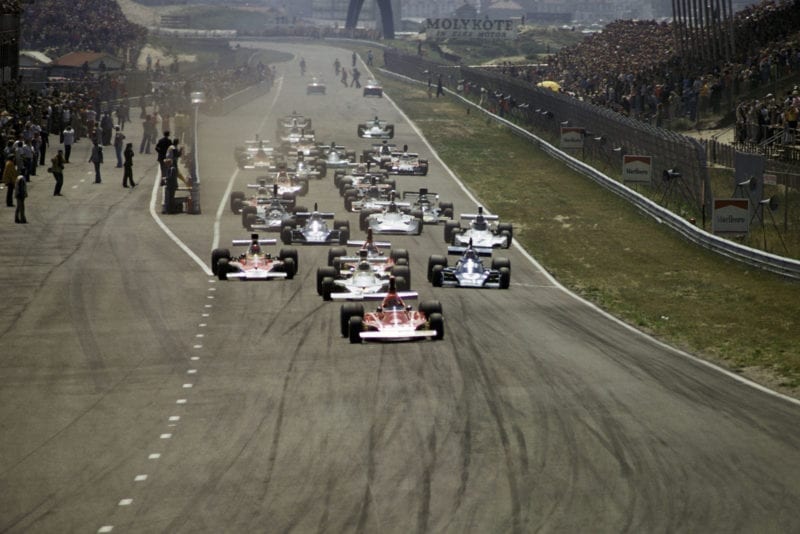
Lauda leads at the start of the race
Motorsport Images
All was fine and dry as the cars assembled in front of the pits to make ready for the race, everyone seeming to be in good order with Reutemann in the third of the BT44 Brabhams, Beltoise in the second of the P201 BRM cars, Ickx in 72/R5 with a new engine installed, Mass in the older Surtees TS16, Pescarolo the P160 BRM and Migault in the first of the P201 BRMs, only because Pescarolo could not fit into it. Lauda made an absolutely text-book start and got to the first corner well in the lead, thus avoiding any nonsense like he suffered at Monte Carlo when Regazzoni held him up. Hailwood got the jump on Regazzoni and was in behind Lauda, while Hunt was slow off the mark, being passed by quite a few cars before he really got under way. He then charged for a gap in the traffic to make up for his slow start, the gap closed and he hit Pryce’s Shadow, sending the black car helplessly off course with a broken right rear suspension, while the Hesketh carried on with a bent left rear suspension. As the dust from this incident was settling Stuck had a private accident two corners further on and ended up in the catch fence where he stayed while the rest got on with the race. From the opening lap “race” was not the operative word, for Lauda simply ran away from everyone, putting on a demonstration that was inspiring for Ferrari enthusiasts, but soul-destroying for anyone else. For one glorious lap Hailwood stayed in front of Regazzoni’s Ferrari, but then the second red car passed on braking for the Tarzan hairpin and it was all over. The demonstration race by the two Ferraris was simple and uncomplicated, Lauda went further and further into the lead, while Regazzoni kept on the pressure and rather than holding back the Cosworth hordes, he was making them pant for breath to keep him in sight, at the same time racing amongst themselves. This was fine, except that it meant that Lauda could not really ease up at all, for if he did his fiery team-mate began to get too close for comfort.
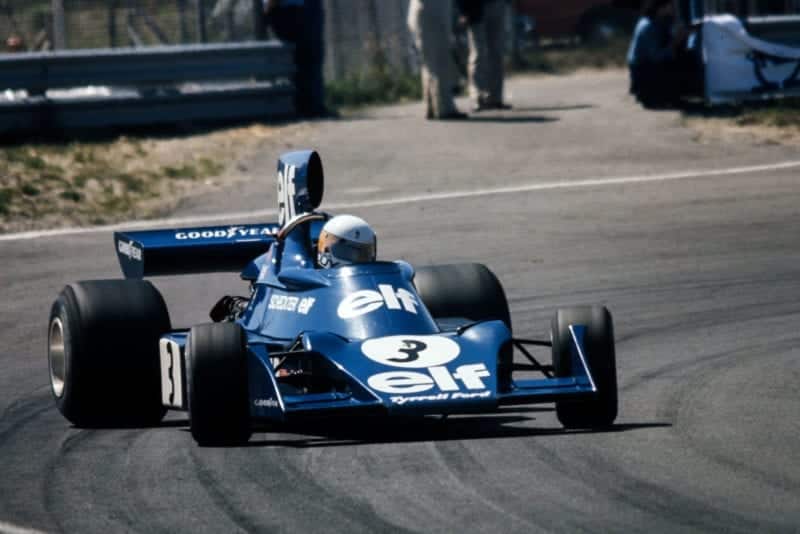
Scheckter takes his preferred line on his way to 5th
Motorsport Images
The Ferraris ran strongly, so there were no problems and round and round went Lauda, never putting a wheel wrong and leading from starting flag to finishing flag, an undisputed winner. Behind Regazzoni the Cosworth race was quite good, though it was of no great significance in the overall picture. Hailwood in the Yardley-backed McLaren led Depailler (Tyrrell), Fittipaldi (McLaren) and Scheckter (Tyrrell), while Reutemann, Peterson, Jarier, Hulme and Watson were tagging along behind. Edwards was leading the rest after Mass had stopped with his engine misfiring, due to grease getting in the electrical master switch! As the grease had come from a split rubber gaiter over a drive-shaft universal joint, he did not leave the pits again. Jarier’s run did not last long as the throttle control cross-shaft in the vee of the Cosworth engine broke. After a long time in the pits having it replaced he got going again, only to stop later with clutch slip. Another car in the pits for a long time was the Hesketh, for after a lap Hunt realised he had damaged his suspension. The damaged links were replaced, but fifteen laps had gone by so M’Lord Hesketh decided it was pointless going on. The moments of excitement in the Cosworth race for third place overall were few and far between, though Depailler livened things up by driving through on the inside of Hailwood on the twelfth lap as they braked for the Tarzan hairpin, and powering round it in a spirited fashion. On the seventeenth lap Peterson did the same thing to Reutemann and Watson would have liked to have been brave enough to do the same thing to Hulme, but the wily old bear made sure he was on the inside of the corner as he braked. Hailwood slipped down into fifth place, behind Fittipaldi and it then seemed to be over, apart from cars falling apart or blowing up. Beltoise retired his BRM with the gearbox showing signs of seizing up, Hill retired his Lola with the back end falling apart, Edwards had to give up with an engine that refused to run properly, Merzario coasted to a stop with a broken gearbox and Migault did likewise, on the same part of the circuit when a small Allen socket-screw fell out of the gear linkage of his BRM. With the end almost in sight Hulme’s Cosworth engine just went dead on him, the ignition unit having failed, and for the rest who did not have trouble it was a case of hoping not to be lapped by the flying Lauda. Depailler’s courageous efforts in third place disappeared as the fuel load went down and his tyres wore down, for the handling of the Tyrrell changed drastically. Although he altered his cornering technique to allow for it, Depailler could not hope to stay ahead of healthy rivals like Fitripaldi and Hailwood, nor even his team-mate Scheckter, but he managed to salvage sixth place.
Watson’s determined drive, keeping up with the “establishment” was negated slightly towards the end of the race when the thin aluminium spoiler-strip across the rear aerofoil became detached at one end and stuck out the back like a radio aerial. Although it was hardly noticeable both Team Lotus cars were still running at the end of the race, though both had been in and out of the pits for a variety of reasons. The most serious was wheel nuts coming loose, due to a fault In the inspection department (assuming Lotus have one), added to which Peterson locked up his front brakes at one point and put flats on his tyres, stopping to have them changed. Anyone who could not stay in the forefront of the Cosworth race seemed to have some sort of “tyre-trouble”, even though most of them were on Goodyear tyres, as were the two Ferraris, which had no trouble at all. Reutemann got confused by this “rubber-herring”, though Schuppan had a visible trouble right in front of the pits, when a tyre burst on the Ensign. He came to a stop just beyond the pits and his mechanics fitted another one on the spot, but it entailed exclusion under the “no work outside the pit area” rule.
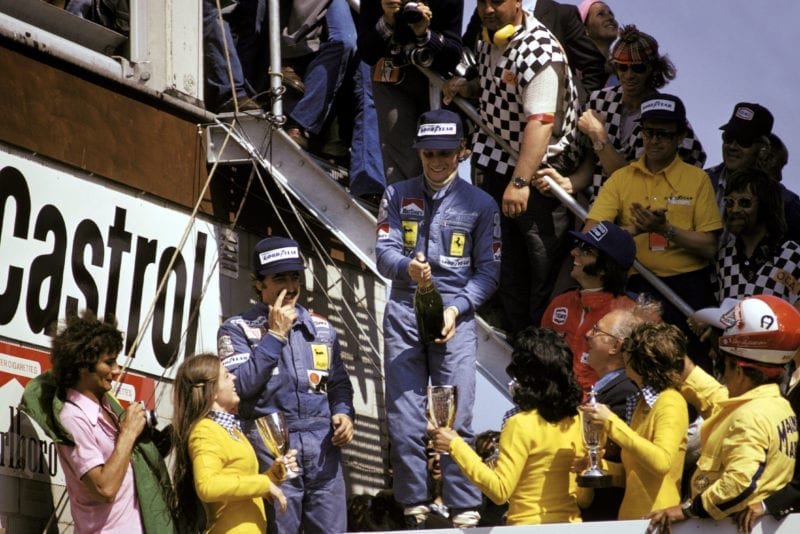
Lauda celebrates on the podium
Motorsport Images
As the Scuderia Ferrari packed up their equipment and loaded their two very healthy cars into the transporter, along with the spare car that had never even been started up, they were all smiles. On their way back to Maranello they were going to call in at the Osterreichring to make preparations for the Austrian Grand Prix on August 18th. The rest went home to lick their wounds or have a serious chat with Keith Duckworth and Cosworth. The BRM team went back to Bourne to their own troubles.
D.S.J.
Results (top five): Zandvoort — 4.226 k./lap, 75 laps
1. N.Lauda – Ferrari – I hr. 43 min. 00.35 sec – 184.628 k.p.h.
2. G. Regazzoni – Ferrari – 1 hr. 43 min. 08.60 sec.
3. E Fittipaldi – McLaren – 1 hr. 43 min. 30.62 sec.
4. M.Hailwood – McLaren – 1 hr. 43 min. 31.64 sec.
5. J.Scheckter – Tyrrell – 1 hr. 43 min. 34.63 sec.
